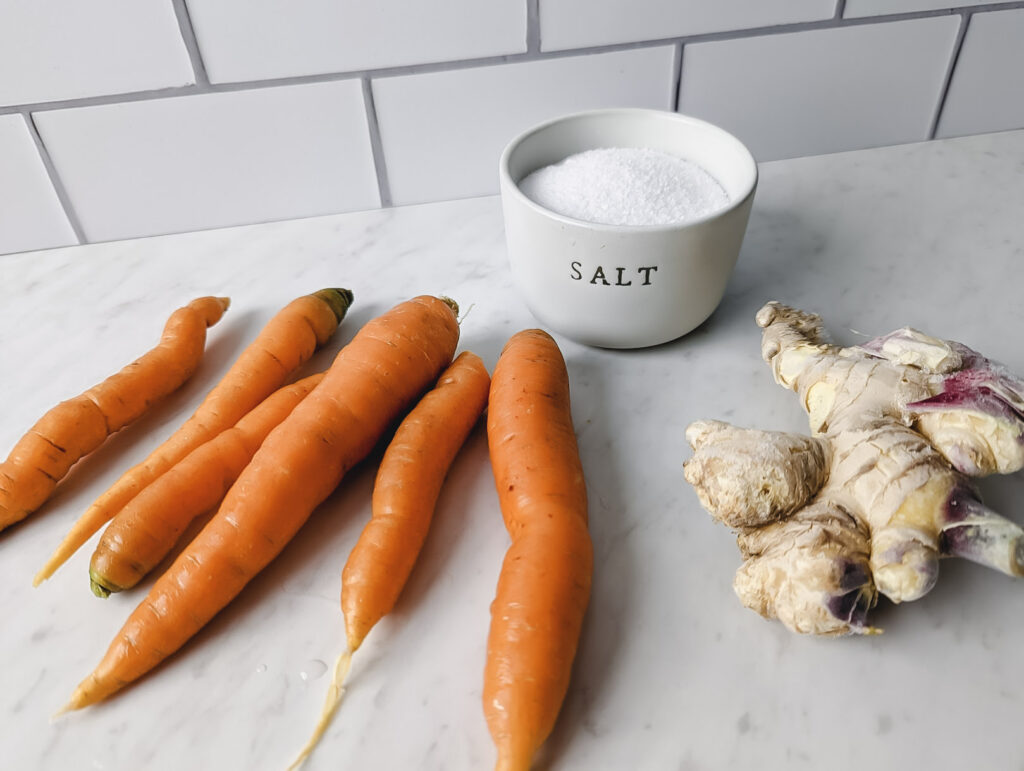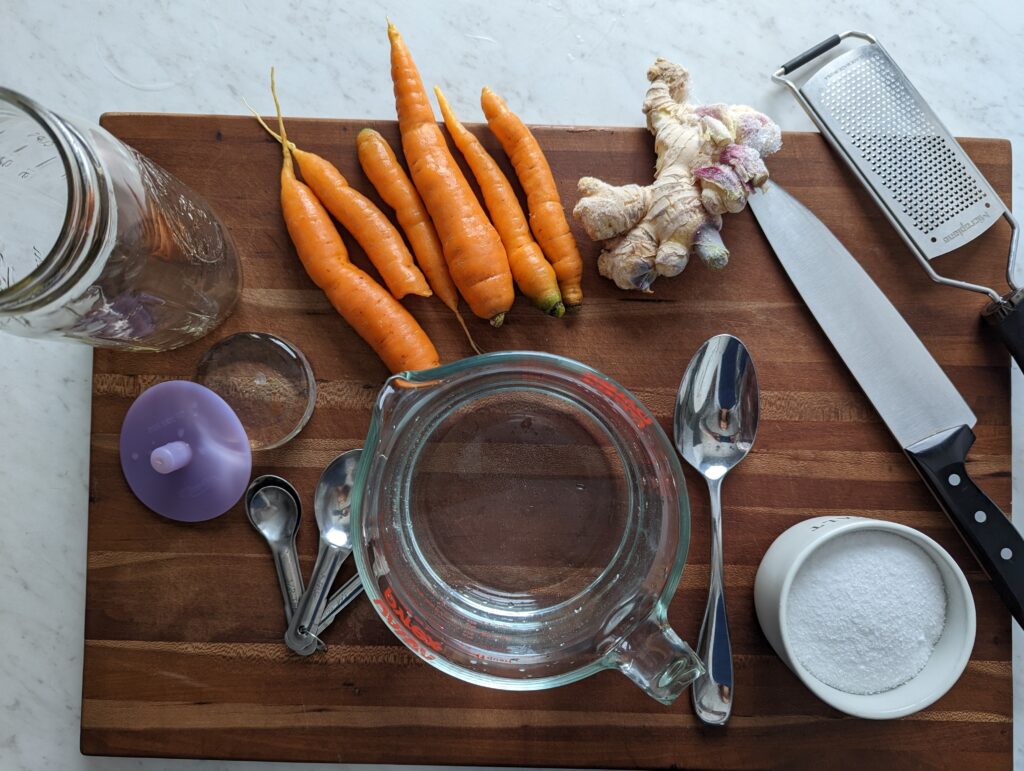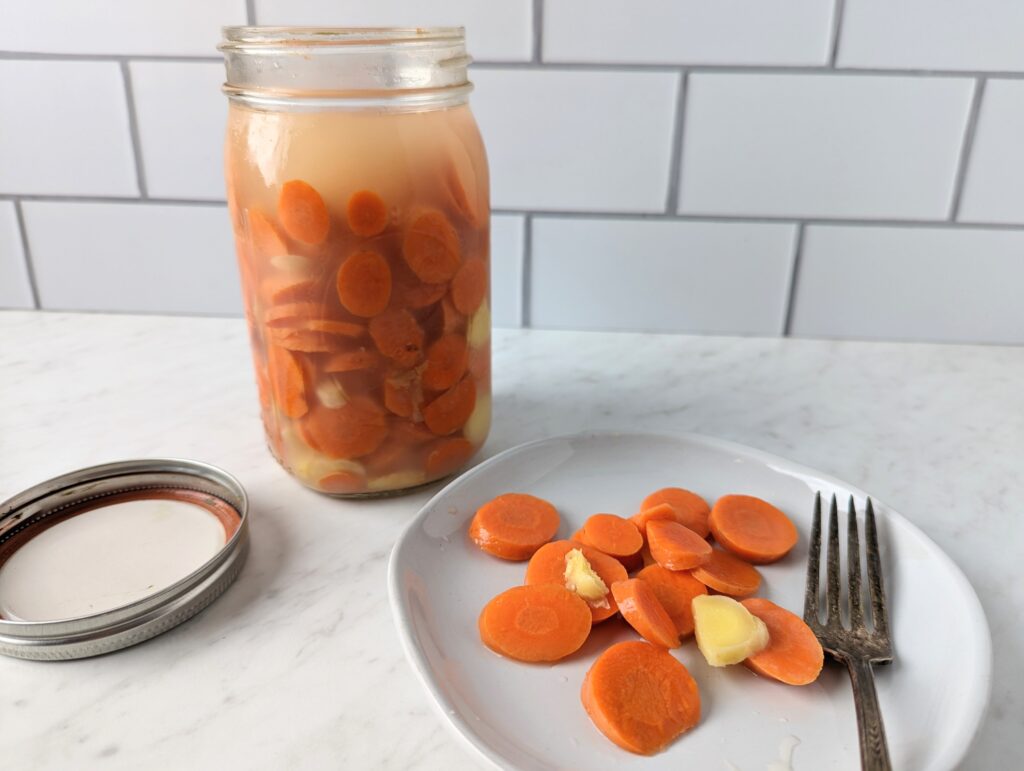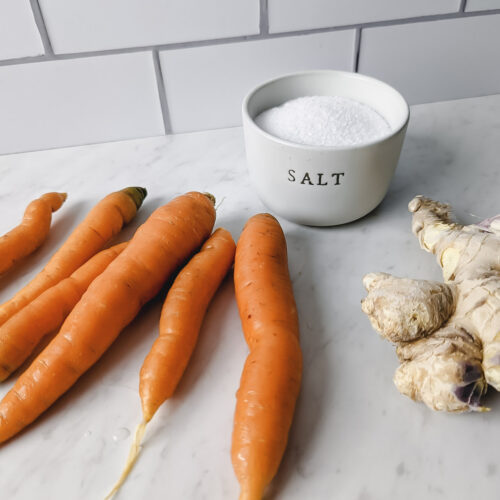This recipe is simple, quick, super tasty, and so good for your gut. It’s full of probiotics, fiber, vitamins (vitamin A, beta-carotene, vitamin C, vitamin K), minerals (calcium, potassium), and phytonutrients (lutein, zeaxanthin) from the carrots and ginger.
If you want to learn more about the benefits of fermented vegetables, check out my other blog posts on 3 important reasons to eat fermented foods and prebiotics, probiotics, and postbiotics. And if you really want to nerd out on why to eat more fermented foods, check out this randomized controlled trial published in Cell in 2021 on fermented foods, microbiome diversity, and immune health. Yup, as an integrative registered dietitian nutritionist, mama, and fellow human with about 100 trillion bacteria living in my gut too. . . I love this stuff.
For this recipe, all you need is 3 ingredients and about 10 minutes. These fermented ginger carrots are brine-pickled and done in 4-5 days. They take less than 10 minutes to make using ingredients you probably already have on hand, they taste delicious, and this same process can be used to make other vegetables you have like beets, radishes, etc.
What you need to make fermented ginger carrots
For this recipe, you’ll need just a few simple ingredients and a few pieces of equipment (fancy fermentation stuff optional).

Ingredients
Wash and scrub about 8 carrots for a 1 quart batch. If they are organic, there’s no need to peel. Carrots are available often from community supported agriculture shares, farmers markets, or at your grocery store.
Use fresh or frozen ginger. You only need about a 1″ knob of ginger.
For the water, use only de-chlorinated or unchlorinated water. Chlorine kills bacteria and we’re trying to grow it! I use double filtered water (charcoal filter) and haven’t ever had a problem with our water killing the culture.
Use sea salt or fine kosher salt. There’s no need to use fancy expensive sea salt, just use what you have as long as it isn’t iodized. Redmond Real Salt works great for ferments and is from the US.
Carrots are sweet. The sugar content in carrots can sometimes lean your ferment towards yeast taking over versus bacteria. If this happens, it’s still edible, it will just turn white-ish and taste more vinegar-y (I’m pretty sure that’s not actually a word). Your goal is for bacteria to predominate so you have lots of probiotics to support your gut in the final product.
There are two ways to nudge your ferment further towards bacteria predominating instead of yeast. The first is to add about 1 tablespoon of sauerkraut juice to your brine and the second is to buy and add a bit of starter culture. There is a third way too I suppose although my kids would ask “why is there cabbage in the carrots?” The third way to nudge the ferment is to add a few tablespoons of shredded cabbage to your ferment. If you want to opt out of all of these nudges, just use the saltwater brine and it will most likely work just fine.

Equipment
For this project, you need a clean 1 quart mason jar with a lid (bare minimum). A boiled rock (yes, for real) will also work to help keep your ferment under the brine.
If you want it to be more hands off and ensure your food stays under the brine (this time and in the future), invest in some fermentation weights and Pickle Pipes. If you have fermentation airlocks from home-brewing, these also work. We’ve drilled holes in canning lids to insert these in. Crude, but it works just fine.
How to make fermented ginger carrots
Head on down to the recipe or watch the video for the process to make these fermented ginger carrots. Here’s a few quick tips:
Store fresh ginger in the freezer to use whenever you’d like. If you store ginger at room temp or in the fridge, it will eventually shrivel up and dry out. Use a microplane to easily grate frozen ginger (this also works great for making ginger tea).
The thicker you slice the carrots, the longer the ferment will take. The thinner you slice them, the less time the ferment will take. You can also cut the carrots into sticks if you prefer. Anything goes, experiment with what you like.

If you want to shred the carrots instead of slicing them, you can make this recipe like kraut by adding the salt directly to the carrots and ginger and packing it tight and covering it to keep out the oxygen. Keep in mind you’ll likely need more carrots! You may need to add a little brine to the top as carrots aren’t as juicy as cabbage and keeping the ferment submerged is key to success.
Remember, when fermenting vegetables, keep the air out! That means keep the veggies under the brine. Lactofermentation is anaerobic- the bacteria produce lactic acid and other acids and byproducts like carbon dioxide NOT in the presence of oxygen.
Some white sediment in your ferment is totally normal. Don’t panic. If there’s a thick white coating over the top or you see strings going into your ferment, you’re dealing with yeast or mold, compost and next time use a starter.
How do you know it’s done? Taste the veggies! If they’re done, they will taste tart, crunchy, a little bit salty, and a little bit spicy from the ginger.
Fermented Ginger Carrots
Equipment
- 1 quart mason jar buy at your local farm, hardware, or grocery store or https://amzn.to/3VLF5BK
- 1 Pickle Pebble work great with any wide mouth mason jars, optional: https://amzn.to/3SujE6F
- 1 Pickle Pipe work great with any wide mouth mason jars, optional: https://amzn.to/3BK8Yen
- 1 wide mouth canning funnel https://amzn.to/3OYFEnm
- 1 Chef's knife not the one I used in the video but a great budget friendly knife I highly recommend: https://amzn.to/3vKjm1E
- 1 Culture starter Body Ecology (opt.) or use sauerkraut juice or just the saltwater brine: https://amzn.to/3SgsPGI
Ingredients
- 4 cups water unchlorinated (filtered, well, boiled and cooled)
- 2 tablespoons sea salt or fine kosher salt
- 8 medium carrots or about 1.5 lbs carrots
- 1 inch knob fresh ginger grated or finely sliced
Instructions
- In a bowl or large measuring cup, combine the water and salt. Stir until all salt is dissolved and set aside.
- Wash and slice carrots.
- Grate or slice ginger and mix well with carrots.
- Add carrots and ginger to a clean 1 quart mason jar.
- Pour saltwater brine over top of carrots until covered. Leave about 1-1/2 inches of head space.
- If desired, cover carrots with a pickling weight to keep submerged under the brine.
- Cover jar with a fermentation air-lock or Pickle Pipe, screw on a canning ring, and set in bowl or dish to catch any overflow.
- Set out of direct sunlight for 4 to 5 days to ferment. Taste. When the ferment is tart, tangy, and to your liking, cover with a canning lid and put in the fridge.
Video
Notes
- This ferment will last at least 6 months in the fridge. At our house, we’re lucky if there is any left in the fridge when the next batch is ready to eat.
- What’s not to love about ginger carrots? My kids don’t love a lot of different veggies but they sure love these.
- To make a half gallon, simply double the ingredients. You may need to add a few more carrots if doubling as you won’t need extra head space for one of the batches.
- If shredding the carrots instead of slicing them, you can make this recipe like kraut by adding the salt directly to the carrots and ginger and packing it tight and covering it to keep out the oxygen. Keep in mind you’ll likely need more carrots! You may need to add a little brine to the top as carrots aren’t as juicy as cabbage and keeping the ferment submerged is key to success.


